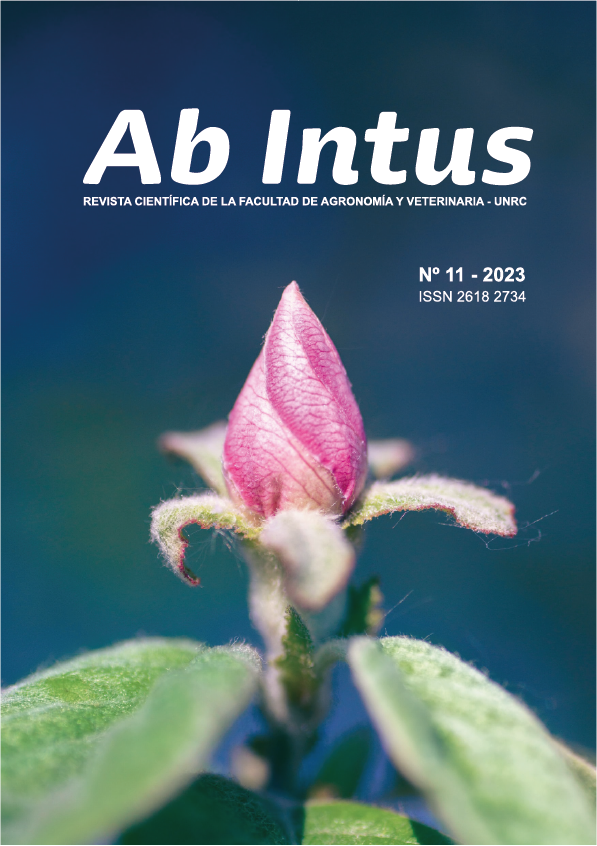Hygiene scoring method in dairy cows
Abstract
Intensification and scaling up of dairy systems oen
leads to increased environmental pressure on animal health and
welfare. To evaluate the performance and evolution of these
systems, simple, applicable indicators easy and cheap to obtain are
necessary. Animal hygiene, related to animal health and welfare, is
useful and practical as an assessment tool. Most of the evaluation
methods respond to the predominant systems of production
and conditions in their place of development, being necessary
a hygiene qualification method adaptable to environmental and
productive conditions of our region. A dairy cow hygiene scoring
system that asses three different anatomical sites (udder, feet, and
upper leg) is proposed. Using five levels that represent percentages
of the evaluated body surface covered by dirt; Scoring from 0 (less
than 5%) to 4 (more than 60%), the values 1, 2 and 3 represent
ranges from 5 to 20%; 20 to 40% and 40 to 60% of the skin surface
covered by dirt, respectively. e score can be given for each
anatomical site and/or a global score per animal can be obtained
by averaging the score given to each site.
Downloads
References
Ariza J.M., Levallois P., Bareille N., Arnoult A., y Guatteo R. 2020. Evaluation of a foot
dirtiness scoring system for dairy cows. Journal Dairy Sci. 103 (5): 4738-4742.
Breen JE, Green MJ, Bradley AJ. 2009. Quarter and cow risk factors associated with
the occurrence of clinical mastitis in dairy cows in the United Kingdom. Journal
Dairy Sci. 92(6): 2551-2561. doi: 10.3168/jds.2008-1369
Cook, N.B. y Reinemann, D.A. 2007. A tool box for assessing cow, udder and teat
hygiene. Proceedings of the 46th Natl. Mastitis Counc: 31- 43.
DeVries, T. J., Aarnoudse, M. G., Barkema, H. W., Leslie, K. E., & von Keyserlingk,
M. A. G. 2012. Associations of dairy cow behavior, barn hygiene, cow hygiene,
and risk of elevated somatic cell count. Journal of Dairy Sci. 95(10): 5730–5739.
doi:10.3168/jds.2012-5375
Ellis, K. A., G. T. Innocent, M. Mihm, P. Cripps, W. G. McLean, C. V. Howard, and
D. Grove-White. 2007. Dairy cow cleanliness and milk quality on organic and
conventional farms in the UK. Journal Dairy Res. 74:302–310.
Guatteo, R., A. Arnoult, J.-L. Menard, and N. Bareille. 2013. Elaboration of a scoring
grid to assess feet cleanliness in dairy cattle and identification of risk factors in the
winter period. Rencontres Recherches Ruminants. 20: 379–382.
Hughes J. 2001. A system for assessing cow cleanliness. Practice. 23: 517-524
Popescu S., Razvan STEFAN, Eva-Andrea; DIUGAN; Cristin BORDA; Marina
SPINU; Carmen Dana SANDRU. 2010. Relationship Between Barn Hygiene
and Lameness Prevalence in irtyFive Transylvanian Dairy Farms. Bulletin
UASVM, Veterinary Medicine. 67(1). E-ISSN 1843-5378
Rajabi Iman, Alireza Taghavi Razavizadeh, Mohammad Azizzadeh, Babak Khoramian.
e investigation on the relationship between dairy cow hygiene scores and
intramammary infections
Reneau, J., Seykora A., Heins B., Endres M., Farnsworth R. y Bey R. 2005. Association
between hygiene scores and somatic cell scores in dairy cattle. JAVMA, 227:
-1301.
Relun, A., A. Lehebel, M. Bruggink, N. Bareille, and R. Guatteo. (2013). Estimation of
the relative impact of treatment and herd management practices on prevention of
digital dermatitis in French dairy herds. Prev. Vet. Med. 110: 558–562.
Rowe S., Tranter W., Laven R., (2021) Longitudinal study of herd udder hygiene and
its association with clinical mastitis in pasture-based dairy cows, Journal Dairy
Sci.104 (5): 6051-6060
Schreiner, D. y Ruegg P. 2003. Relationship between udder and leg hygiene scores and
subclinical mastitis. Journal Dairy Sci. 86: 3460-3465.
Tadich, N. 2011. Bienestar animal en bovinos lecheros. Revista Colombiana de Ciencias
Pecuarias. 24(3): 293-300. ISSN: 0120-0690.
Welfare Quality Consortium. 2009. Welfare Quality Assessment Protocol for Cattle.
Welfare Quality Consortium, Lelystad, the Netherlands
Published
Versions
- 2023-08-10 (2)
- 2023-08-01 (1)
How to Cite
Issue
Section
License
Copyright (c) 2023 Ab Intus

This work is licensed under a Creative Commons Attribution-NonCommercial 4.0 International License.


















